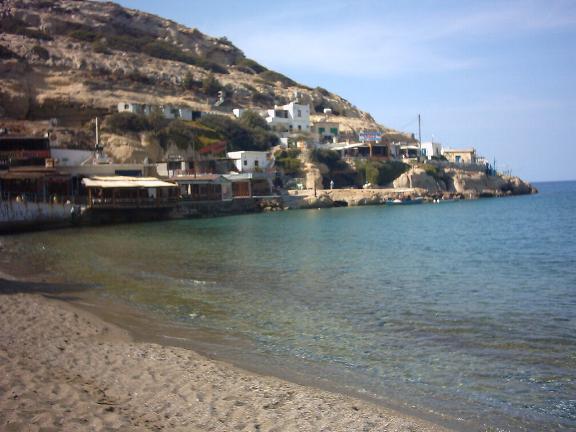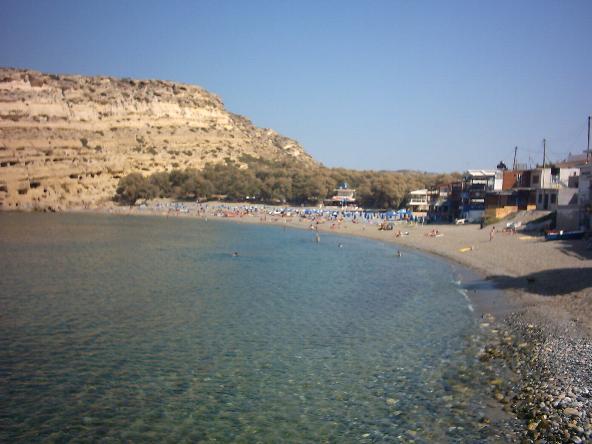MATALA

The town beach of Matala with its umbrella's and beachchairs, and in the distance the islands called Nisia Paximadia.
Matala located 71km southwest of Iraklion via the Iraklion - Agia Varvara - Agii Deka - Mires - Matala road is on the coast, south of the town of Timbaki. Matala is quite a large, busy and touristic town with a good range of tourist facilities from which you can easily reach the archaeological sites of Festos, Agia Triada, and Gortyn. Various other beaches of southern Crete are also nearby (like the beautiful Kommos Beach). Matala has remains of Minoan, Greek, Roman and early Byzantine eras. It's also commercial and at the beach there is paid parking like in Vai.

The caves in the rock.

Part of the village
The roads from Iraklion are good and a direct trip will take 2 hours. From Matala, Agia Galini in the southern part of Rethimnon prefecture is easily reached. Ierapetra although further, is an equally interesting journey. There are frequent buses to the these destinations as well as many other local ones.

Overview of the townbeach of Matala.

My favourite picture: a boat and the stairs leading down to it.
Matala was originally the harbour of Festos during the Minoan and Greek period, and when Gortyn defeated Festos in 220 B.C., it became the harbour of Gortyn. Traces of the ancient settlement are seen on the bottom of the sea.

The clear water of the sea.
Matala has revised its former image of a hippie settlement and there are presently no signs of that era. Now it has many attractive tourist facilities and a pleasant ambience. There is a market that has a bazaar atmosphere with many shop doors opening onto the covered street.

Some boats floating in the sea.
Matala is famous for its man-made caves which were first inhabited during the prehistoric period. Tombs found in the caves date from Greek, Roman and Early Christian times. The 1960s and early 70s brought an influx of foreigners to the area and the caves attracted numerous international hippies and other free-spirited travellers. Today, the Archaeological Service protects the fenced-off caves. The sandy beach is semi-circular and 300 metres in length. Despite its size the beach can become quite overcrowded. A path along the rocks will bring you to the “red sand” beach after a 25-minute walk.

The pebbles at the end of the beach.